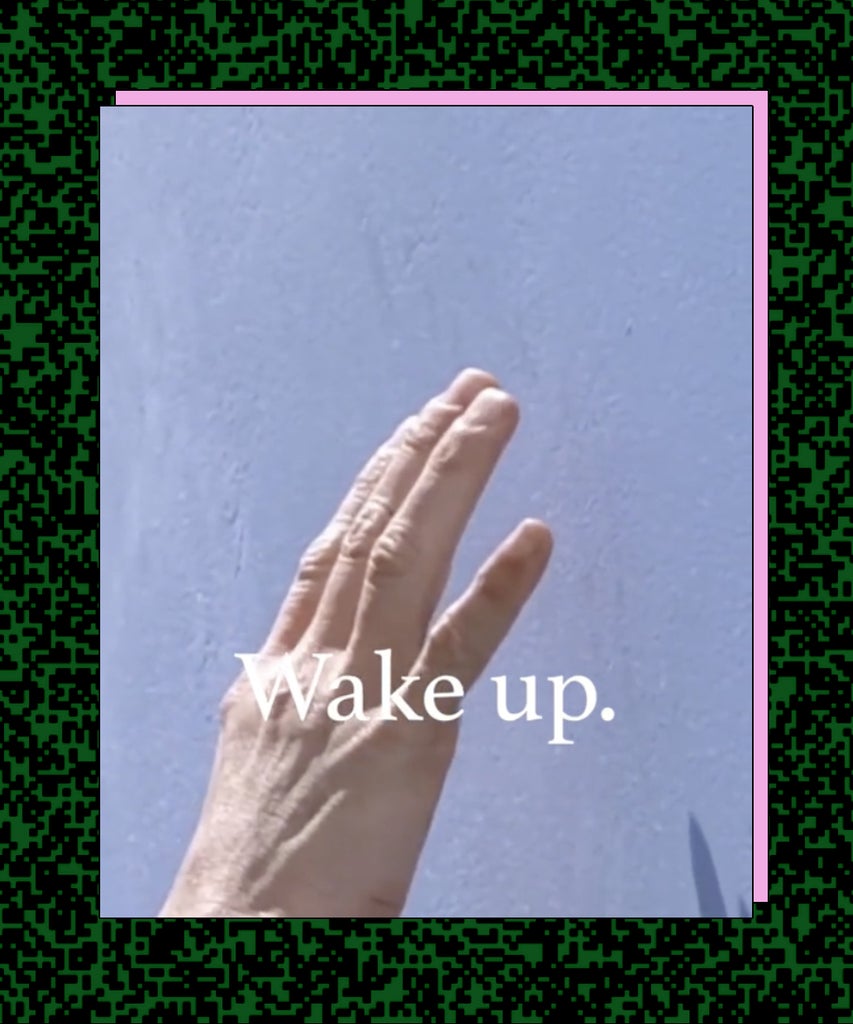
It seems like every #core under the sun has existed on the internet, tickling the fancy of all aesthetics that matter. Cottagecore? Live out your country town dreams, love. Gorpcore? Pass the Tevas. Oh, and normcore? Dressing like a literal, actual, average person has also already been and gone as a trend. So perhaps it was only a matter of time before the most meta of internet subcultures was to surface. Please welcome to the stage, Corecore.
Think of Corecore as shitposting, but sincere. It’s a style of editing that sees niche videos layered upon each other haphazardly to disorient the viewer and share a message about society. It’s like the TikTok version of a speech by the Joker in the Batman franchise or a “wake up sheeple” reminder in bite-sized form, commenting on consumerism, addiction, loneliness, sadness and technology — and their various cross-sections.
@sebastianvalencia.mp4 Wake up. #corecore #nichetok ♬ original sound – Sebastian V
Corecore, or “niche-tok”, is fundamentally anti-“core” in the first place, explains YouTube commentator Angle TV. “At first, [Corecore] seems to be this meaningless compilation of videos that aim to try to connect to a shared message. But it’s the idea of Corecore that has some more depth to it than you would probably think,” he adds about the fundamental aesthetic of “cores” in the first place. He explains that we use “cores” to explain current shared experiences, genres and ideas.
“Corecore is basically the antithesis of that idea. Its existence is in the fact that it can be anything: it can connect any type of media to funnel a central idea and I think that is what makes these videos so interesting to watch… [It has] become the self-examination or rebranding of what a core or an aesthetic can be,” he says.
Corecore is about being self-aware about the norm we comfortably accept, and its sudden uptake in the mainstream hints at a desire to step away and “unplug” from social media (while still being on social media). Videos with millions of likes splice together pop culture moments of people snapping like Ryan Gosling in Blade Runner 2049 or Bojack Horseman having an existential unravelling montaged together with sombre clips of vices like gambling, or embedded TikToks of vloggers venting about their lives.
At best, Corecore presents a problem without offering solutions, and at worst, is already being hijacked to feed deep-rooted insecurities.
Perhaps what is most interesting about Corecore is when it turns its gaze back onto the very host it harbours itself on: TikTok. With more than a billion monthly users on the app globally, TikTok is a breeding ground for different and conflicting stances where every man and their dog has an opinion — even if the algorithm presents you mostly content that already aligns with your own personal politics. But by showing these points of view butting heads against one another, Corecore encourages us to be introspective about the absurdity of life and Western culture.
At best, Corecore presents a problem without offering solutions, and at worst, is already being hijacked to feed deep-rooted insecurities. An edit by @amepersanthony about the toxicity of modern dating culture is already splitting the internet for perpetuating incel-like thoughts about women and their supposed vapidity. On the other side of the coin, Corecore can also be used to make a compelling argument about certain states of affairs in a collage-like format, like how society treats trans people.
But why are we talking about Corecore now? After two-plus years of a pandemic coupled with a cost of living crisis, it’s only natural that people are feeling disillusioned about the world around them and have reached a bursting point, ready to discuss and critically analyse the injustices that are out of their control. Take, for example, the recent Recessioncore trend, which has seen celebrities respond to a crumbling economy by pretending to not be a part of the problem. Corecore tries to achieve the opposite by looking at the issues directly instead of reacting to them.
But don’t get us wrong, Corecore isn’t the start of a revolution and it’s very likely that its format will soon fade away into the background as all viral moments do. But what this visual think tank has achieved is planting both the seed of discontent and class consciousness into the minds of viewers, not so much telling them what to think, but still nudging them to do so on their own terms. Corecore pushes its audience to question the higher forces at play instead of accepting things as they are, but it falls short of telling us what’s next. As one TikTok comment read on a viral Corecore clip, “this is like an essay with no thesis”.
However, under the illusion of profoundness is pure angst that, when examined under the microscope, isn’t really saying anything we don’t already know. Like ouroborus — the ancient symbol of a serpent eating its own tail — Corecore is the result of TikTok being pushed to the limit and running out of things to dissect, and therefore, turning on itself. Yes, we know the world is a shitty place, but Corecore isn’t going to change that. What it triggers next, if anything at all, might just offer a glimmer of hope.
Like what you see? How about some more R29 goodness, right here?
I Have An Issue With The Vanilla Girl Beauty Trend